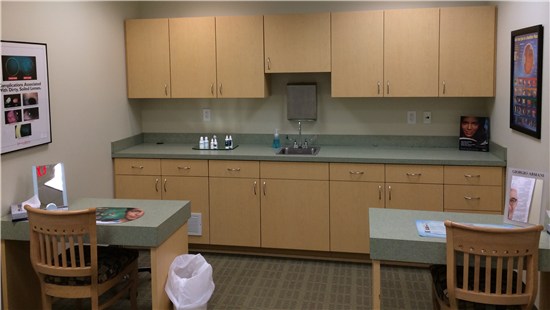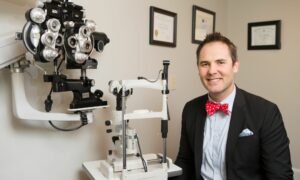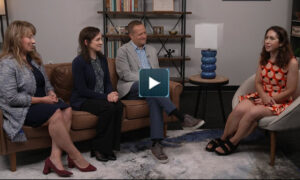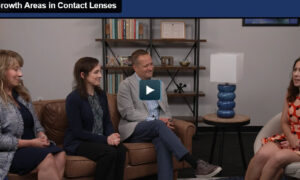By Ian Benjamin Gaddie, OD
SYNOPSIS
Provide ocular comfort and visual acuity in mature contact lens patients. They are highly valuable to your practice over time.
ACTION POINTS
IDENTIFY MULTIFOCAL CANDIDATES. Greater than 50 percent of contact lens patients over age 40 could be contact lens candidates.
ENSURE A HEALTHY OCULAR SURFACE PRIOR TO FITTING. If the ocular surface of the eye isn’t healthy and comfortable, then contact lens wear won’t be either.
CREATE A PREMIUM PRACTICE ENVIRONMENT. Multifocal contact lenses are premium products requiring a premium patient experience in your office.
Maintaining the eye health, comfort and visual acuity of all of my contact lens patients–including those in middle and older age–is essential to my practice. I also monitor the ocular surface of all my patients currently wearing contact lenses and ensure that I treat any underlying ocular surface condition prior to prescribing multifocal contact lenses, which I feel can lead to greater contact lens success for a longer period of time.

The contact lens room in Dr. Gaddie’s practice. Dr. Gaddie says that 50 percent or more of his patients age 40 and older could benefit from multifocal contact lenses.
Identify Candidates for Multifocal CLs
In my practice, 50 percent or more of the contact lens patients aged 40 and older could benefit from multifocal contact lenses. I have had the opportunity to fit an increasing number of patients in multifocal contact lenses. However, many of my peers have still not picked up on this opportunity to meet the vision and comfort needs of this patient demographic.
It is important to recognize that not all patients are good candidates for multifocal contact lenses or full-time multifocal contact lens wear such as those having significant astigmatism or those requiring long hours of detailed up-close work.
Emmetropes often require additional adaption time and positive reinforcement so that their adaption time is normal. Proper patient selection and education on expectations and visual performance goes a long way toward patient satisfaction.
Ensure a Healthy Ocular Surface
An important consideration in our presbyopic contact lens wearers is the increased prevalence of dry eye, particularly in women over age forty. Symptoms don’t always manifest as discomfort, but could manifest as visual fluctuation or an inability to achieve good visual acuity all day. Some patients may complain of foggy vision causing their doctor to change the contact lens material or solution, when in fact, they should assess their ocular surface. I carefully assess the patient history and ocular surface at each visit.
Use Diagnostic Instrumentation to Educate
I use diagnostic instrumentation such as Telscreen anterior segment imaging, to show the patient images of the ocular surface, pointing out evidence of dryness or other issues that need to be treated in order to maximize the chance of successful contact lens wear. I also routinely flip superior lids and take anterior segment photos of the palpebral conjunctival to educate on signs of allergy and the need for treatment or a daily disposable multifocal. I also video or photograph lipid deposits in case I need to educate on better compliance or change contact lens materials or modalities.
In my practice I use diagnostic tests such as TearLab and InflammaDry to determine the baseline tear chemistry and inflammation levels on patients prior to contact lens fitting. Once we start therapy for ocular surface disease, we recall the patient for repeat diagnostic testing looking for evidence of improvement on these markers. I prefer to extinguish the inflammation on the ocular surface before refitting, particularly in patients who may have previously dropped out of lens wear due to discomfort.
Create a Premium Practice Environment
In our practice, we rarely have pushback from patients on the fees of any of our products or services, including multifocal contact lenses. We have built a premium practice with an environment that sends the message that our practice brand is high quality in all regards–including the contact lenses we prescribe.
When we do have challenges to our fees or methods, it presents an opportunity to explain what the patient can expect to achieve in terms of vision at all distances and how the lenses work to minimize impact to the ocular surface with their unique surface technology.
Conversations that Will Lead to Improved Outcomes
Most people know that presbyopia is associated with getting older, so having your doctor tell you that you need progressive eyeglasses and multifocal contact lenses isn’t the most enviable position in which to find yourself. Sometimes a patient who says they don’t have any trouble seeing up close, will show through my refraction that they need a +1.50 add. In those cases, I will ask follow-up questions such as whether they are having trouble reading their e-mail on their phone, texting or helping their children with their homework. Often, patients are able to decide for themselves that it’s time for near vision correction after they answer those questions.
If I sense a patient’s anxiety over needing progressives or multifocal contact lenses, I will personalize the discussion by telling them: “Well, I’m 44 and already wearing them, and you’re 46, and you’re just getting them now, so you’re doing great!” Most have no idea that I’m wearing a multifocal contact lens or spectacle lens, so they can see for themselves that they won’t look different.
Invest in Staff Training
Our main scribing technicians are in the exam room with the doctors at all times, including multifocal contact lens fitting and evaluations. We’ve invested in training our staff members, so they can interact with and educate our multifocal candidates and wearers with accuracy and professionalism. We provide them with the opportunity to attend state and national continuing education classes related to contact lenses, and representatives from contact lens manufacturers visit our office to educate them about the materials, methods and rebates to help us deliver an annual supply of lenses to the patient. We also participate in clinical trials of new multifocal contact lenses, which give our staff a chance to learn even more.
We have staff work with patients to practice contact lens insertion and removal, and to help with case histories and trouble-shooting when a patient is experiencing discomfort or poor visual acuity. Keeping our contact lens patients’ eyes healthy, comfortable and with the best possible visual acuity, is a priority for us.
Related ROB Articles
Full-Day CL Comfort: New Technology Lets You Provide It
Multifocal CLs: Aging Population Makes This a Practice-Builder
5 Ways to Turn Skeptical Patients Into Contact Lens Wearers
Ian Benjamin Gaddie, OD, FAAO, is a partner with Gaddie Eye Center in Louisville, LaGrange and Carrollton, Ky. To contact: ibgaddie@me.com



























